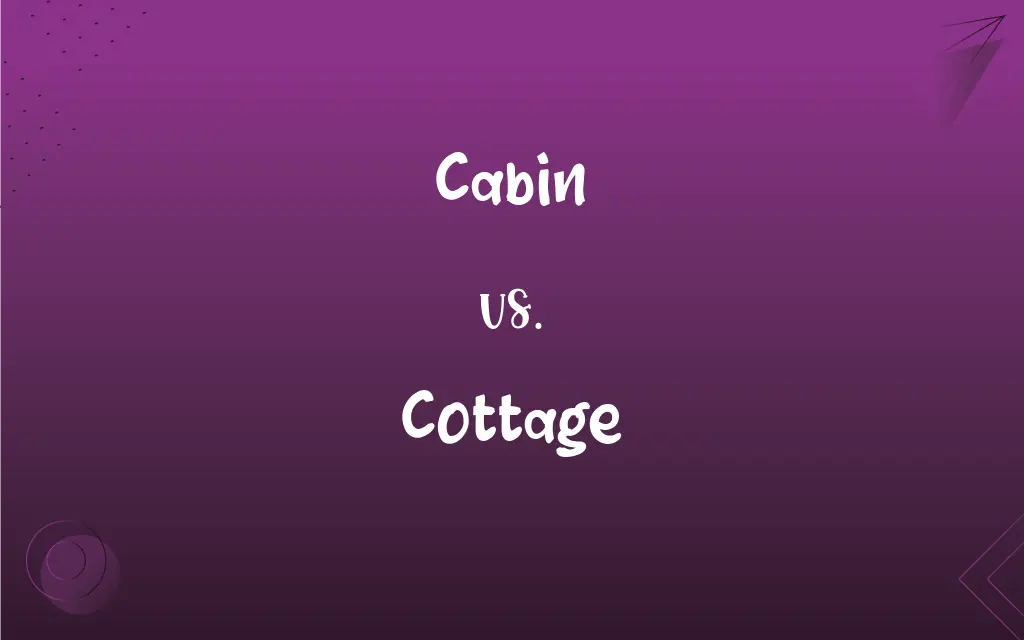Cabin vs. Cottage: What's the Difference?
Edited by Aimie Carlson || By Harlon Moss || Updated on July 1, 2024
Cabins are often simple wooden structures, typically in wild or remote areas. Cottages are small houses, often in rural settings or villages, with a quaint or charming appearance.

Key Differences
A cabin primarily refers to a simple structure, often made of logs or lumber. The term often evokes images of the wilderness, forests, mountains, or lakeside retreats. Cabins are typically basic in their design, often built for function over aesthetics, meant for short-term stays or as secondary residences.
In contrast, a cottage is generally thought of as a small, quaint house, often found in rural settings or villages. The architecture and design of a cottage are often charming and can be more detailed than that of a cabin. Cottages may have gardens or be adorned with flowers, adding to their picturesque nature.
While both cabins and cottages can be used for vacationing, the former is more associated with rugged, off-grid living, whereas the latter often symbolizes a serene and peaceful escape in a village-like setting. Regardless of their differences, both provide a sense of solitude and a break from urban hustle.
Comparison Chart
Primary Material
Often made of logs or wood
Typically made of brick, stone, or wood
Location
Found in wild or remote areas
Common in rural settings or villages
ADVERTISEMENT
Design
Simple and functional
Quaint and charming, often detailed
Purpose
Retreats, secondary residences, off-grid living
Vacation homes, primary residences in rural areas
Associated Image
Wilderness, forests, lakes
Countryside, gardens, village-like settings
Cabin and Cottage Definitions
Cabin
A structure in remote or wild areas.
The secluded cabin offered a perfect escape.
Cottage
A small house, often in rural settings.
She inherited a cottage from her grandparents.
ADVERTISEMENT
Cabin
A simple wooden shelter.
They spent the weekend in a mountain cabin.
Cottage
Quaint dwelling with charming aesthetics.
The white cottage had blue window shutters.
Cabin
A room on a ship where passengers stay.
Their cruise cabin had a beautiful ocean view.
Cottage
A residence with a garden or yard.
Flowers bloomed outside the stone cottage.
Cabin
Small, often temporary, dwelling.
The researcher lived in a cabin during the expedition.
Cottage
Represents a peaceful, village-like abode.
The artist drew inspiration from the countryside cottage.
Cabin
A compartment for specific uses.
The pilot instructed us from the cabin.
Cottage
A small home used for vacationing.
They rented a seaside cottage for the summer.
Cabin
A small, roughly built house or shelter.
Cottage
A small, single-storied house, especially in the country.
Cabin
A room in a ship used as living quarters by an officer or passenger.
Cottage
A usually small vacation house.
Cabin
An enclosed compartment in a boat that serves as a shelter or as living quarters.
Cottage
A small house.
FAQs
Are cottages always small?
Generally, but some can be spacious, retaining a quaint appearance.
Where are cottages commonly found?
Cottages are usually in rural settings or villages.
Do cabins have a historic significance in the U.S.?
Yes, they're integral to American frontier history.
What's a "thatched cottage"?
A cottage with a roof made of straw or reeds.
Can a cabin be luxurious?
Yes, while cabins are often simple, some are designed with luxury in mind.
Is "log cabin" a redundant term?
Not necessarily. It emphasizes the cabin's log construction.
Is a cottage typically a single story?
Often, but two-story cottages exist.
Can a cabin be mobile?
Some cabins, like modular ones, can be relocated.
Can a cottage be part of a larger property?
Yes, it can be a smaller dwelling on a large estate.
Are cabins always in forests?
No, but they are typically in wild or remote areas.
Can a cottage be in the city?
It's rarer, but city dwellings with cottage-like features can exist.
Do all cabins have modern amenities?
Not always. Some cabins are off-grid or rustic.
Are cottages often associated with gardens?
Yes, many cottages have gardens or floral adornments.
Can a cabin be a permanent residence?
While often for retreats, some people do live in cabins year-round.
Can a cabin be on a ship?
Yes, a cabin can refer to a room on a ship.
Are cottages often old or historic?
Many are, but modern cottages are also built.
Are cabins always standalone structures?
Typically, but some larger properties might have multiple cabins.
Are cottages exclusive to certain countries?
No, but their design and features might vary by region.
What is a cabin typically made of?
A cabin is often made of logs or wood.
Is a cottage often a vacation home?
Many are, but they can also be primary residences.
About Author
Written by
Harlon MossHarlon is a seasoned quality moderator and accomplished content writer for Difference Wiki. An alumnus of the prestigious University of California, he earned his degree in Computer Science. Leveraging his academic background, Harlon brings a meticulous and informed perspective to his work, ensuring content accuracy and excellence.
Edited by
Aimie CarlsonAimie Carlson, holding a master's degree in English literature, is a fervent English language enthusiast. She lends her writing talents to Difference Wiki, a prominent website that specializes in comparisons, offering readers insightful analyses that both captivate and inform.































































